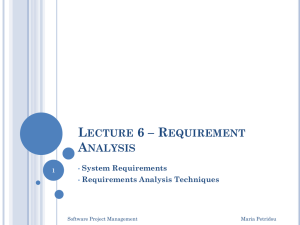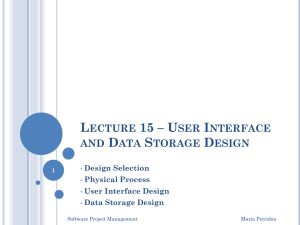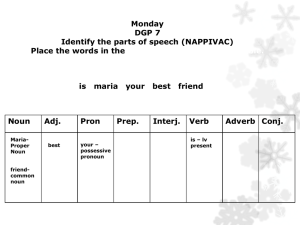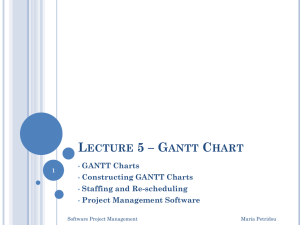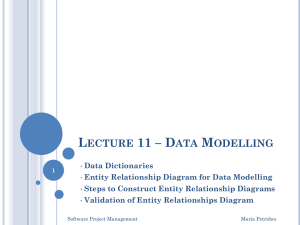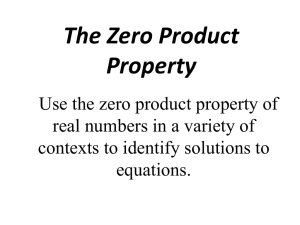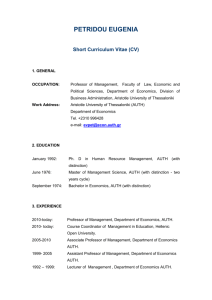PERT Diagrams & CPM
advertisement
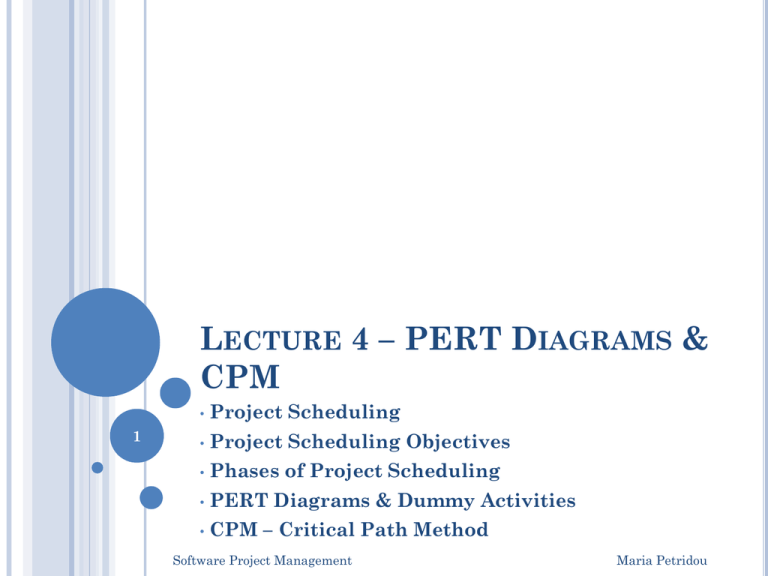
LECTURE 4 – PERT DIAGRAMS & CPM 1 • Project Scheduling • Project Scheduling Objectives • Phases of Project Scheduling • PERT Diagrams & Dummy Activities • CPM – Critical Path Method Software Project Management Maria Petridou PROJECT SCHEDULING It is part of project management within the Planning phase of the Systems Development Life Cycle. Project Scheduling: Allocate resources to execute all activities in the project. Project: Set of activities or tasks with a clear beginning and ending points. The amount of available resources (time, personnel and budget) to carry out the activities is usually limited. Software Project Management 2 Maria Petridou PROJECT SCHEDULING Objectives: Establish beginning, ending and duration of each activity in the project. Calculate overall completion time of the project given the amount of usually limited resources. Determine the critical path and its duration. Determine the slack time for all non-critical activities and the whole project. Guide the allocation of resources other than time such as staff and budget. 3 Software Project Management Maria Petridou PROJECT SCHEDULING Phases: Define activities or tasks according to the project objectives. A task is an individual unit of work with a clear beginning and a clear end. Identify precedence relationships or dependencies Estimate time required to complete each task. Draw an activity-on-arrow PERT diagram inserting dummy activities if required. Apply CPM to calculate earliest and latest starting times, earliest and latest completion times, slack times, critical path etc. Construct a GANTT chart. Reallocate resources and resolve if necessary. Continuously monitor/revise the time estimates along the project duration. Software Project Management 4 Maria Petridou PERT DIAGRAMS Program Evaluation and Review Technique It is a network model that allows for randomness in activity completion times. Tool used to control the length of projects. PERT was developed in the late 1950’s for the US Navy’s Polaris Project. First used as a management tool for military projects Adapted as an educational tool for business managers It has the potential to reduce both the time and cost required to complete a project. 5 Software Project Management Maria Petridou PERT DIAGRAMS 3 1 A 2 5 F 6 4 Single start node Single finish node 6 Software Project Management Maria Petridou PERT DIAGRAMS Activity-on-node diagrams: Maybe more than one single start and end node Nodes represent activities Arrows indicate precedence Activity-on-arrow diagrams: One single start and one single end node Arrows represent activities Nodes indicate beginning/end of activities 7 Software Project Management Maria Petridou PERT DIAGRAMS Activity-on-node Activity-on-arrow 8 Software Project Management Maria Petridou PERT DIAGRAMS Some basic rules for Activity –on-arrow: Tasks are represented as arrows Nodes represent the start and finish points of tasks There is only one overall start node There is only one overall finish node Two tasks cannot share the same start and end node. B A 2 3 D C Tasks B & C share the same start and end node Software Project Management 9 Maria Petridou DUMMY ACTIVITIES Sometimes it is necessary to insert dummy activities (duration zero) in order to maintain the clarity of the diagram and the precedence relationships between activities. In activity-on-arrow PERT diagrams, each activity must be uniquely identifiable by its start and end nodes. However, sometimes multiple tasks have the same predecessors and successors. 10 Software Project Management Maria Petridou DUMMY ACTIVITIES Case One A task should be uniquely identifiable from its start node and finish node This means that two or more tasks cannot share the same start and finish nodes B 1 A Task D has immediate predecessors of B and C Software Project Management 2 3 C D 4 Tasks B and C have the same start and finish nodes 11 Maria Petridou DUMMY ACTIVITIES Inserting a dummy activity can ensure that multiple tasks have different successors. 1 A A new node is inserted to give C a different finish node to B Software Project Management 2 B 4 3 D 5 A dummy task is inserted to preserve the immediate 12 predecessors of D Maria Petridou DUMMY ACTIVITIES Case Two A task should be uniquely identifiable from its start node and finish node This also means that a task cannot have more than one start node and one finish node In other words… two different arrows cannot represent the same task. Software Project Management Maria Petridou DUMMY ACTIVITIES Possible Solution One One option would be to insert activity E as shown below, but this changes the precedence of E and provokes that D and E share both start and end nodes. Ending node of task B and C, but task C has a precedence ONLY task C Task D and E have same start and end nodes Software Project Management Maria Petridou DUMMY ACTIVITIES Possible Solution Two Another option would be to insert activity E as shown below, but this provokes C to have two different end nodes. Two ending nodes for Task C Software Project Management Maria Petridou DUMMY ACTIVITIES Correct Solution! The solution is to insert a dummy task so that the precedence of E is preserved and activity C remains uniquely identifiable. Software Project Management Maria Petridou CPM – CRITICAL PATH METHOD It is determined by adding the times for the activities in each sequence. CPM determines the total calendar time required for the project. If activities outside the critical path speed up or slow down (within limits), the total project time does not change. The amount of time that a non-critical activity can be delayed without delaying the project is called slack-time. 17 Software Project Management Maria Petridou CPM – CRITICAL PATH METHOD ET – Earliest node time for given activity duration and precedence relationships LT – Latest node time assuming no delays ES – Activity earliest start time LS – Activity latest start time EF – Activity earliest finishing time LF – Activity latest finishing time Slack Time – Maximum activity delay time Software Project Management 18 Maria Petridou CPM – CRITICAL PATH METHOD Step 1. Calculate ET for each node. For each node i for which predecessors j are labelled with ET(j), ET(i) is given by: ET(i)= maxj [ET(j)+ t(j,i)] where t(j,i) is the duration of task between nodes (j,i). Step 2. Calculate LT for each node. For each node i for which successors j are labelled with LT(j), LT(i) is given by: LT(i)= minj [LT(j) – t(i,j)] where t(j,i) is the duration of task between nodes (i,j). Software Project Management 19 Maria Petridou CPM – CRITICAL PATH METHOD 2 1 5 C(7) 3 4 20 Software Project Management Maria Petridou CPM – CRITICAL PATH METHOD 2 0 1 5 C(7) 3 4 21 Software Project Management Maria Petridou CPM – CRITICAL PATH METHOD 3 2 0 1 5 4 C(7) 3 4 22 Software Project Management Maria Petridou CPM – CRITICAL PATH METHOD 3 2 0 1 5 4 C(7) 3 11 4 23 Software Project Management Maria Petridou CPM – CRITICAL PATH METHOD 3 13 2 0 1 5 4 C(7) 3 11 4 24 Software Project Management Maria Petridou CPM – CRITICAL PATH METHOD 3 13 8 2 0 1 5 4 C(7) 3 11 4 25 Software Project Management Maria Petridou CPM – CRITICAL PATH METHOD 3 13 8 2 max 0 1 5 4 C(7) 3 11 4 26 Software Project Management Maria Petridou CPM – CRITICAL PATH METHOD 3 2 0 13 1 5 4 C(7) 3 11 4 27 Software Project Management Maria Petridou CPM – CRITICAL PATH METHOD 3 2 0 13 1 13 5 4 C(7) 3 11 4 28 Software Project Management Maria Petridou CPM – CRITICAL PATH METHOD 3 2 0 13 1 13 5 4 C(7) 3 11 11 4 29 Software Project Management Maria Petridou CPM – CRITICAL PATH METHOD 3 8 2 0 13 1 13 5 4 C(7) 3 11 11 4 30 Software Project Management Maria Petridou CPM – CRITICAL PATH METHOD 3 8 2 0 13 1 13 5 4 4 3 C(7) 11 11 4 31 Software Project Management Maria Petridou CPM – CRITICAL PATH METHOD 3 5 8 2 0 13 1 13 5 4 4 3 C(7) 11 11 4 32 Software Project Management Maria Petridou CPM – CRITICAL PATH METHOD 3 5 0 8 2 0 13 1 13 5 4 4 3 C(7) 11 11 4 33 Software Project Management Maria Petridou CPM – CRITICAL PATH METHOD 3 5 0 8 min 2 0 13 1 13 5 4 4 3 C(7) 11 11 4 34 Software Project Management Maria Petridou CPM – CRITICAL PATH METHOD 3 8 2 0 0 13 1 13 5 4 4 3 C(7) 11 11 4 35 Software Project Management Maria Petridou CPM – CRITICAL PATH METHOD An activity with zero slack time is a critical activity and cannot be delayed without causing a delay in the whole project. 36 Software Project Management Maria Petridou CPM – CRITICAL PATH METHOD Step 3. Calculate processing times for each activity. For each activity X with start node i and end node j: ES(X) = ET(i) EF(X) = ES(X) + t(X) LF(X) = LT(j) LS(X) = LF(X) – t(X) Slack Time (X) = LS(X) – ES(X) = LF(X) – EF(X) Where t(X) is the duration of activity X. An activity with zero slack time is a critical activity and cannot be delayed without causing a delay in the whole project. 37 Software Project Management Maria Petridou CPM – CRITICAL PATH METHOD Step 3. Calculate processing times for each activity. Task Duration ES EF LS LF Slack Critical Task A 3 0 3 5 8 5 No B 4 0 4 0 4 0 Yes C 7 4 11 4 11 0 Yes D 5 3 8 8 13 5 No E 2 11 13 11 13 0 Yes Reading: (Kendall&Kendall, chapter 3), (Dennis &Wixom, chapter 3) Software Project Management 38 Maria Petridou CPM – CRITICAL PATH METHOD 3 8 2 0 0 13 1 13 5 4 4 3 C(7) 11 11 4 39 Software Project Management Maria Petridou
